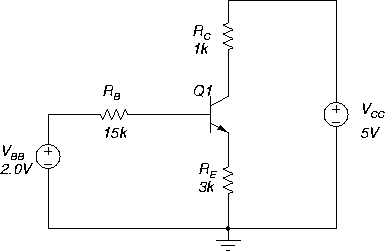 |
Load the PSPICE file bjt-dc3.sch, Figure 35. This circuit will have the same DC bias as the amplifier circuit of section 7.5.
Lecture Notes : BJT Transistor Circuits : DC Bias
Exercise:
It may be helpful to refer to the transistor characteritics obtained earlier (it is the same transistor).
Enable DC sweep and simulate again. Obtain plots of IC and VCE vs RE, (something like Figure 36). (Recall that VCE=VC-VE!)
Note carefully the effect of RE on IC and VCE.
The horizontal intercept is VCC=5 V, and the vertical intercepts are given by

Plot the operating point Q corresponding to item 1 (on the RE=3 k![]() load line).
load line).
ANU Engineering - ENGN2211